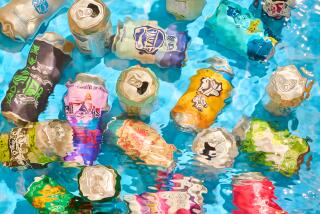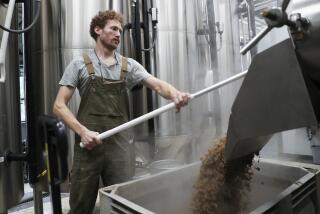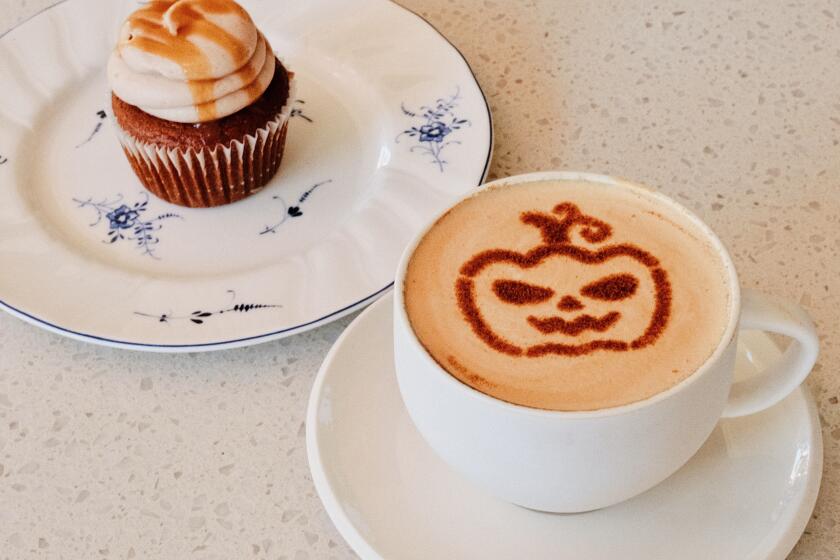Broomstick Whomps Steel Floor at 6 a.m. : Coors Production Starts With Bang
GOLDEN, Colo. — The “jungle-drum method” of brewing began with a whomp to the steel floor at 6 a.m.
Using a broomstick, Gil Ortega, supervisor of the multimillion-dollar pilot brewery at Coors, was signaling that the grains were ready to drop to the brewhouse a floor below. Hot water flowed into the mash tun--a large kettle--and the ceiling was smacked in reply from below to tell Ortega he could let the grains fall.
“We use radios a lot--many times we’re doing things four floors away. When we don’t have two-way radios with us, we signal on the floor with a broomstick,” Ortega said.
“Making beer is fun,” he said later, and laughed. “It breaks the ice at 6 a.m.”
The 30-barrel pilot brewery’s uses include testing new crops of barley and hops and creating new beers. The facility is tucked into the Coors plant, the world’s largest single brewery, which last year produced 13.2 million barrels of beer (a barrel is 31 gallons). Masters beer is produced here.
Coors, the nation’s fifth-largest brewer, is expanding eastward, opening a beer-packaging plant in Virginia’s Shenandoah Valley in 1987. Officials of the company, which was founded in 1873, look toward being a national brewer by 1990.
The pilot brewery, which was started in 1975, is one-sixteenth the size of the main brewery’s production equipment and is among the largest pilot breweries in the world, according to Finn Knudsen, director of Coors brewing research and development.
Most of the Work Done In-House
“We are trying to duplicate production as much as possible. We’re successful in doing it--we can take the results from the pilot brewery and implement it immediately,” he said.
Knudsen said of the facility’s cost that, if you built “a pilot brewery of the same capacity and the same flexibility, it would have cost more than $2 million. But since most of the work was done in-house, it’s difficult to get a precise figure.” The brew kettles are the only major piece of pilot-brewery equipment bought from outside, from Huppmann in West Germany, he said.
A day at the pilot brewery begins for Ortega at 4:30 a.m.
After a short breakfast, he arrives at the brewery here. Ortega located a fork lift, maneuvered it away from 200- and 400-pound sacks of hops, and used the truck to lift a steel container--of grains that were ground earlier--into place over the mash tun, where the grains are heated with water to convert the starches to sugars. Now it was time for the broomstick to signal to the floor below.
When he gets an answering knock, Ortega climbs a ladder and helps push the grains through the hole to the brewhouse.
On the method of communicating, Ortega said: “Just because we’re computerized and automated doesn’t mean we’re not making beer the way we did 100 years ago.”
A 50-year-old brass and copper desk is used in the pilot brewery when samples are taken from various stages during the brewing process.
“The desk was rescued from the old brewhouse when they modernized it,” said Ortega, who has been the pilot-brewery supervisor for seven years. “Whenever any of the Coors family comes up, they admire this desk. It adds a nice touch.”
Intense High Notes
The Coors’ hops room is where the hops for a test brew were weighed. Steve Gress, a senior research associate in brewing research and development, who studied music in graduate school, rubbed the hops between his palms and identified them variously as having “soprano or bass notes.”
“Soprano is the sharp, intense high notes--citrus, grassy, wintergreen, pungent--the violins, piccolos,” said Gress of the smell of a particular hop variety. Several varieties of hops, which give beer its bitterness, are blended in most beers. Some hops are selected for their aroma, some for their bitterness.
Rubbing another variety, Gress, who also has a chemistry background, described “the more subtle smell of hops--the bass notes, the cellos.”
Asked why he selected a particular mix of hop varieties for this test brew, he said: “There’s still art to the process.” Gress said he gets teased occasionally about the descriptions, “but people know what I’m talking about.”
A different way to talk about beer is heard at the flavor-profile panel upstairs at the main brewery after they tasted three beers: Coors Light, 3.2% alcohol Coors and regular 3.6% alcohol Coors.
“Lunch meat, solvent, woody, soapie, papery, juniper, spicy” were some of the comments from the six tasters on the panel, one of four tasting panels at Coors.
Because of the variables in tasters--being on the verge of a cold, for example: “If one person makes the comment, we don’t worry. If three people (say it), we would have called it a problem. The beer would not go out the door,” said Kathryn Word, supervisor of sensory analysis.
She noted that most large U.S. breweries, including Coors, have “sensory panels” and depend on a group--”not the single judgment of a brewmaster”--to eliminate the gaps that can occur in one individual’s tastes.
For any beer to go to production, it must be considered by:
- Discriminative panel. Members get three beers, two alike, and answer if there is a difference in flavor among the beers.
- Flavor-profile panel. Members are asked to describe the difference in flavors.
-Drinkability panel. Panelists answer, “Is the perceived flavor difference a good or bad quality?” Word said. This panel meets at a bar built upstairs at the brewery and individual members also taste beers in evaluation booths that resemble the stalls in college library stacks.
In addition, there’s a fourth panel, on product formulation, that includes family members Joe and Bill Coors, Jeff, Pete and John Coors, several other board members as well as Knudsen, Gress and Ortega, “and is the major decision-making panel,” a company spokesman said.
Coors has between 600 and 700 tastings a year, about three tastings a day on average. The discriminative and flavor-profile panels operate under red lighting “so there are no visual clues--the only variable is the taste,” Word said.
In addition, between samples, panelists rinse their mouths, take a bite of unsalted cracker, and rinse again. Samples are served in stemless glasses that resemble brandy snifters.
As a day in the pilot brewery nears the end, the mash filters, which are used to strain the grains, are hosed down.
The brewing day ended at 4:30 p.m., as the yeast was added and the drums fell silent.
More to Read
Eat your way across L.A.
Get our weekly Tasting Notes newsletter for reviews, news and more.
You may occasionally receive promotional content from the Los Angeles Times.









